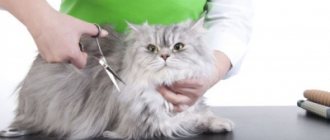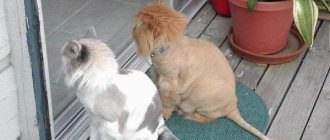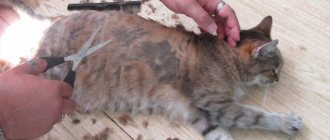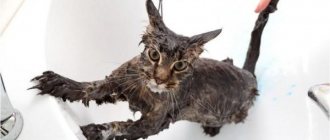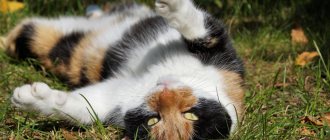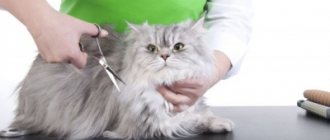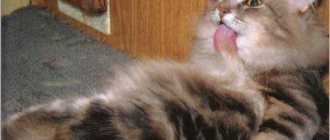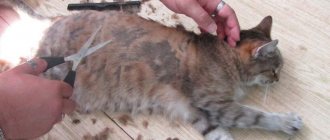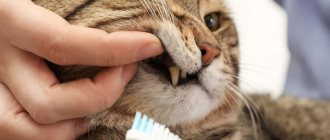Grooming (shaving) cats and kittens is a procedure that can be used for medicinal and some other purposes (hygienic haircut, etc.). Let's figure out what these cases are, whether and how to shave a cat correctly and beautifully at home.
What will be discussed in the article is based on the author’s personal experience, as well as on the experience of other cat breeders and on theoretical knowledge of cat physiology. Somehow the groomers mistakenly shaved my cat to 3mm instead of combing out the shedding fur as I asked. As a result, my mood was ruined for a long time, and we are still seeing the consequences to this day. I must say that I personally am against shaving cats for the sake of beauty or the convenience of the owners, but I cannot help but notice that many other owners, including professional breeders, practice this procedure. Therefore, let's look at the problem from different angles.
Article continues after advertisement
Why does a cat need fur?
To understand why you don’t need to just shave your cat’s head, let’s dive into physiology. Wool performs not only an aesthetic function. Its main purpose is protection from cold and heat, insects and damage. Wool helps with thermoregulation (maintaining a constant body temperature) by protecting against direct sunlight and cold. Hairless cats can burn in the sun and freeze very quickly in the cold. Those. in the heat they are more susceptible to overheating, and in the cold - hypothermia.
In winter, cats grow a lot of hair and shed the excess in the summer. Especially a lot of thick undercoat is shed, which helps keep warm in winter. Having shed for the summer, short-haired cats, as a rule, do not need a haircut in the heat. But for long-haired cats with too thick hair, it may be too hot - some owners cut their hair to alleviate the condition.
Often, long-haired cats feel better after a haircut, but at the same time, they are then more susceptible to drafts and the influence of air conditioning, and are more vulnerable to weather changes. In addition, after shearing, the hair grows back finer, so it becomes tangled more easily. And the skin may become less elastic and drier. In rare cases, after shaving and trimming, the hair may not grow back at all.
In addition, the hair creates an air gap around the cat. When the air temperature is high, this layer remains stable. A kind of thermos effect occurs. Remember how in the desert, instead of undressing, people put on fur or other warm clothing. This is done to maintain body temperature.
Therefore, if there is another way to alleviate the animal’s condition in the heat, it is better to use it. You can read about this in this article. But the topic of our article is not the heat, but haircuts and shaving. And it can be produced for different purposes, not just because of the heat. Let's figure out when it is shown and when it is not.
Design features: blades, weight, functionality
The result and comfort of using the machine depends on the type and quality of the blade. The best material is overheat-resistant ceramics. Less popular steel blades are considered durable, but the metal has high thermal conductivity: it heats up faster and cools down more slowly.
It is important to know! It is strictly forbidden to sharpen the blades yourself: violation of the factory balancing leads to rapid breakdown of the device. It is recommended to purchase replacement cutting elements or contact sharpening specialists.
The weight of the device should be optimal: not very light, but not heavy either. Lightweight machines are more difficult to control and vibrate too much. Large devices are less maneuverable and quickly tire your hands. Ergonomics is an important, but very subjective parameter. The machine must lie comfortably in the hand, otherwise operation will cause discomfort to the user and the pet.
The functionality of the machines lies in the presence of various adjustments to the speed of movement of the blades. The wider the settings, the more convenient it is to select the optimal operating mode.
In conclusion, it is worth paying attention to the equipment. There are many different interchangeable attachments, the use of which reduces the time required for cutting and allows you to achieve excellent results. Among the most popular, experts highlight attachments for:
- different parts of the body;
- cutting wool of different lengths.
If there are several animals of different breeds in the house, you should select accessories in accordance with the anatomical characteristics of each breed.
Is it possible to shave a cat bald?
The answer to the question whether it is necessary and whether it is possible to cut a cat’s fur will be both “yes” and “no”. You definitely can’t completely shave a cat. But a 3 mm haircut is sometimes indicated. There are situations in which a cat needs to be shaved. These are, first of all, medical indications for such a procedure as a hygienic haircut:
- foci of fungus and other skin infections;
- a large number of tangles, when it is easier to shave them than to cut them out;
- weeping wounds and ulcers: shaving in such cases is indicated on the affected areas to make it easier to apply medications;
- the animal became so dirty that it was impossible to wash it off;
- shaving certain areas before surgery and ultrasound;
- the animal sheds heavily and swallows a huge amount of hair, which creates a threat of blockage of the gastrointestinal tract: in this case, you can shave until the cause of excessive shedding is eliminated.
Shaving, indeed, allows you to stop severe shedding when the house is literally drowning in fur. This helped in our situation: we went to the groomers with a request to comb out the hair, but in the end they solved the problem completely. Naturally, if the cat is prone to such shedding, as soon as the fur grows back and the season comes, the problem will arise again. Those. shaving, in fact, does not solve the problem, but only hides it: short hairs continue to fall out, but this is no longer noticeable.
What happens if you shave a cat's head directly depends on the color and individual mental traits of the cat, as well as on the conditions in which it lives. For example, smoke-colored cats are cut and shaved with great care, but color-point cats should not be cut or shaved. Many who are reading these lines now will object, they say, they have points, they were shaved - and everything is fine. Yes, some points are fine. But in the classic version, the points darken after that. Tested on mine and many other cats. Smoky and tipped colors also run the risk of deterioration.
Article continues after advertisement
As for other conditions, many cats have a psychologically difficult time with the shaving process and its consequences. And also, because In cats, after shaving, the heat exchange that is maintained by the hair is disrupted; in the first time after the procedure, the cat may freeze, even despite the warmth around.
Is it necessary and possible to have a haircut?
If we exclude the owner's pursuit of his aesthetic interests, then in some circumstances it is not only possible, but also necessary to trim the cat.
Grooming cats is advisable for long-haired breeds. They are characterized by such features as the formation of matted tangles and regular contamination in the tray when performing natural needs.
However, they are not the only ones who suffer from too rich fur coats. The reason for cutting any breed can be:
- summer heat. Even short-haired cats can hardly tolerate it;
- heavy shedding. A haircut has its own benefits for the owner: less hated hair in the house and no need for combing. For a cat, this is a guarantee that lumps will not form in the stomach and everything will be fine with digestion.
So, there are many reasons to get a haircut. Even if we do not take into account the aesthetic side of the problem. The only question that remains is: how to cut and how much hair to leave on the body?
The right tools
But let's say you have a good reason. Then you need to stock up on the right tools. You can, of course, try to shave a cat with a human clipper, but this usually leads to injuries and a poor-quality haircut. Human and animal hair differ in structure and thickness, so clippers for cats and dogs are different in a number of ways. And it’s also better not to use an ordinary razor, that is, a machine: the cat will resist - then you can injure both it and yourself. In addition, shaving with a machine is inconvenient.
The procedure is performed with a special cat shaving machine. It can be purchased in online stores. It is advisable to choose a machine with a power of at least 45 watts. Cat knives are usually produced in the following sizes:
- 0.5 mm (when you need to open a place for hygiene procedures);
- 1.5-1.6 mm (when you need to remove very matted hair close to the skin);
- 3.2 mm (standard shaving).
It is the length of 3 mm with a slight plus that allows you to ensure that the fur remains soft enough and does not prick, causing itching. But if you use a knife much longer than 3 mm, noticeable transitions with jagged edges will appear, which looks careless.
Advantages and disadvantages
Buying a clipper is beneficial for ordinary animal lovers, owners of purebred cats, breeders and groomers. But this technique also has a number of disadvantages associated with the characteristics of its individual varieties and the quality of inexpensive models. For ease of comparison, all the pros and cons are summarized in a table.
Positive aspects Negative nuances Saving on professional services. You can cut your pet's hair yourself and completely free. This is especially important if there is more than one four-legged family member in the house. Some animals are very afraid of even the quietest appliances, which forces owners to switch to mechanical machines. Reducing stress. At home, animals are less nervous and resist, so the result will be better: smooth, short hair, no injuries on the pet’s skin and human hands. You need to adapt to manual models so that the haircut is smooth and the process does not take too much time. Autonomy The wireless battery model can be taken on a trip, for example, to an exhibition. The cable of a wired clipper may be too short, interfere with the hairdresser, or distract the cat. Quality of haircut. With scissors it is difficult to achieve the same effect that any machine, even a manual one, can give. If the kit only includes basic attachments, additional attachments will have to be purchased separately, which will significantly increase costs. Safety
The special device will not harm the cat if the instructions and precautions are followed. A human clipper can cause pain to an animal, even if used very carefully. Cheap devices pull and pull hairs, injure the skin, their blades quickly become dull, and the devices themselves can fail after several haircuts. High-quality machines are not cheap. The battery charge may not be enough for the entire procedure
How to shave a cat with a clipper: grooming a cat at home
Now we’ll tell you how to shave a cat at home yourself. For this you will need:
- shaving machine;
- strong helper;
- muzzle;
- scotch;
- hydrogen peroxide and cotton wool (in case of injury).
Some owners want to use sedatives, sleeping pills or anesthesia to prevent the cat from escaping, but the only thing you can use at home is a sedative. It is better not to take risks with sleeping pills, and there is no need to do anesthesia, even if you send the animal to a grooming salon or veterinary clinic. Many groomers and veterinarians, by the way, themselves sin by putting animals under anesthesia or giving sleeping pills for their own convenience. But this is unjustified. Anesthesia has its own health consequences, so it should only be used for surgical procedures.
Step 1: Disarm
Before the procedure, a muzzle is put on the cat, and the tips of the paws are sealed with tape so that it does not scratch. There are, of course, cats who do not fight even while shaving, but there are few of them, so such safety measures are almost always indicated.
Many cats hate bathing, brushing, and any attempts to tidy up their fur. Some scratch and bite heavily. For a biting cat, you can use a muzzle, but sometimes a muzzle does not help, because... the brutalized animal manages to remove it or even bites it through the fabric. In this case, a special plastic helmet, which was recently invented by the Chinese, will come to the rescue. The cat definitely won't chew it through. Once again, the Chinese managed to come up with a great thing that helps against especially evil cats!
Step 2: Commit
Ask your grooming partner to hold the cat so it doesn't run away when it hears the whirring of the clipper. Let him fix it first, and only then you start shaving.
Step 3: Shave
You can place the cat on its side, fixing all four paws, and start cutting from the sides, moving to the back. You can start shaving from the back. It depends on what you are more comfortable with.
Article continues after advertisement
If you already know that your cat especially doesn’t like touching in certain places, then you should end the procedure with them rather than start.
Cats' paws, tail and face are not shaved or cut. That is, these areas are always left untouched: the so-called “puss in boots” and “lion” haircuts. This is not at all connected with aesthetics, but with the fact that on the face and paws there are vibrissae - whiskers that perform the function of sensory organs: hundreds of nerve endings approach them, each vibrissae corresponds to its own part of the brain. Vibrissae help the animal navigate in space and form a picture of the surrounding world.
When shaving, the machine can be driven both along the fur and against it, lifting the hairs.
If a cat has mats, they are first cut off and then they start shaving.
You need to shave your groin, belly, nipple area and armpits very carefully. Groomers often use separate attachments for this.
Step 4: bathe
Usually cats are given a bath after shaving. Washing allows you to speed up the process of dying off the old wool and finally washes off the already cut hair. However, most cats are so stressed after shaving that bathing would be unnecessary for them, and therefore groomers decide not to bathe, but only wipe the fur with a damp cloth.
Why do you need to cut your pet's hair short from time to time?
Grooming, or trimming a cat's fur, is necessary for many reasons. These include keeping a person’s home clean, caring for a pet, preventing intestinal diseases, allergies and maintaining hygiene.
Owners of long-haired cats should be aware that their pet loses hair all the time, and not just during the shedding season. Therefore, it is advisable to periodically cut your pet's hair short to maintain its health and cleanliness in the house.
For your information! Grooming also helps to avoid tangles, which cause suffering to the cat, provoke the growth of bacteria, and disrupt blood flow and heat exchange.
The frequency of haircuts is affected by the breed and the rate of fur growth. Long-haired pets should be trimmed more often, for example, British chinchillas, Maine Coons and Redgalls should be trimmed once every five months. To begin with, the wool must be washed, dried, combed with brushes, and then trimmed. You can do this yourself or in a specialized salon.
Grooming a cat with thick, long hair
How long does a cat's hair grow after shaving?
How long a cat's fur grows after trimming and shaving is mainly influenced by genetics and nutritional balance. For example, my cat gained about 2 mm in length in 1-2 days. This is the normal rate of hair growth for cats. At first it looked like a waffle towel - a pitiful sight, although it was pleasant to touch (reminiscent of a mouton). Two weeks passed and the animal was in more or less decent shape. After about six months, as the groomers promised, the coat regained its previous length. On average, this is what happens.
However, as expected, the blue point cat was very dark on the body. It looks disgusting, so we're waiting for it to fade. There is little hope that after molting, the previous light shade will at least be restored a little.
But many owners complain that the cat’s hair does not grow well after a haircut. This also happens. And in rare cases, there may be areas of baldness where the hair does not recover at all.
Cons: unpleasant consequences of a haircut
- Grooming, like bathing, is a stressful procedure for a cat. After it, the animal may look sad, depressed, and out of resentment, it may begin to ignore the owner. Particularly proud pets may leave a “surprise” in the owner’s slippers in retaliation for encroaching on their fur coat.
- After cutting, the structure of the hairs of the coat changes: they become somewhat thinner. In addition, the animal's color may become lighter.
- If the hair is cut too short, the cat risks overheating in the sun or catching a cold due to hypothermia under the air conditioner or in a draft. Dryness of the skin and loss of elasticity are also possible.
- In some cases, after a haircut, hair does not grow back on some areas of the skin, that is, alopecia occurs. It is caused by hypothermia and a change in the correct growth of hairs. This pathology usually occurs in dogs, but occasionally occurs in cats. If bald spots began to appear before the haircut, do not try to solve the problem with its help: a veterinarian’s consultation is necessary.
What to do if you shave your cat?
Finally, some practical advice in case you have an almost hairless cat running around the house, which until recently was fluffy.
- Don't laugh at her appearance. Your ridicule may make her depressed.
- Make sure that the house is warm at first and there are no drafts. If the house is cool and your cat is freezing, I recommend training her to wear light clothing.
- While the cat's fur is growing, it may need extra calories for warmth, so it may be necessary to increase its daily food intake slightly. But you still can’t go beyond the norm in terms of weight and age. If you increase the portion too much, the cat will become overweight.
- If your cat is very stressed after a haircut, you need to give her a day or two to calm down. Most calm down without outside help. But if the stressful condition does not go away, you will have to ask the veterinarian for a mild sedative.
- If a cat licks itself after a haircut, this is normal. Firstly, this is how she tries to restore order to the fur. Secondly, it clogs the foreign odor obtained during the procedure. Thirdly, this is how the cat “washes away” stress.
- If a cat is trembling after a haircut, this may be due to both impaired heat exchange, that is, she is cold, and stress. If the cat’s behavior has not changed in general after the haircut and there is only tremors, then clothing is enough to keep her warm.
- If your cat itches after a grooming, this may be due to discomfort due to the new length of fur, as well as irritation and damage to the skin during the procedure. Cats can also itch because less than 3 mm is left: the itching will stop as soon as the fur grows a little. In addition, the animal may be bothered by the cut hairs remaining on the skin: this happens if the cat is not bathed after shaving.
Rate and share!
What diseases can be detected
A haircut can help identify various diseases that the pet owner didn’t even know about. Skin diseases (lichen, eczema and others), an abundance of parasites are often discovered after the grooming procedure. It helps to get rid of many problems; in addition, short hair is better washed with medicated shampoos.
The appearance of bald patches, peeling of the skin, redness, high body temperature are symptoms that grooming specialists pay attention to. The most common diseases include problems associated with the coat and skin.
If your pet intensively combs, licks, or bites its fur, it is worth shortening it and examining the skin.
Bald spots and rashes can be caused by ticks, lice, and fleas. Ringworm, mycosis, is dangerous not only for cats, but also for humans. A haircut allows you to recognize the disease in time and begin treatment. Cats are also susceptible to cancer, the symptoms of which may include dull fur, spots on the skin, and swelling.
